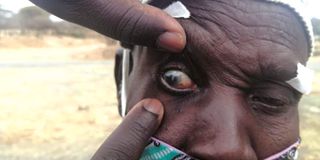Kenya, Uganda treat over 7,000 pastoralists for trachoma in joint drive

Trachoma-infected eyes.
What you need to know:
- It was observed that the mapped-out villages have common characteristics such as high poverty levels and poor access to clean water or effective sanitation.
- Trachoma is the leading cause of avoidable infectious visual impairment and blindness worldwide and is caused by the bacteria Chlamydia trachomatis.
A joint team of health workers from Turkana and Uganda have treated more than 7,000 pastoralists for trachoma during a Mass Drug Administration (MDA) in Napak and Moroto districts in Northern Uganda. This is where a majority of Turkana pastoralists have migrated to for pasture.
The officials mapped out trachoma endemic villages along the border for a targeted joint MDA exercise two weeks ago.
This was aimed at controlling the Neglected Tropical Disease that is caused by a contagious bacterial infection of the eye. The MDA is part of the World Health Organization SAFE Strategy (Surgery, Antibiotics, Facial cleanliness and Environmental changes) to control the blindness-causing disease.
However, Kenya failed the 2020 WHO target to eradicate trachoma.
The healthcare workers have been targeting pastoralists from border villages in Turkana West and Loima sub-counties on the Kenyan side and those in Napak and Moroto Districts in Uganda.
Turkana County Eye Coordinator Samson Lokele said although trachoma prevalence rate in the county has dropped from 8.9 per cent in 2010 to the current 0.5 per cent, the disease is still troubling the highly mobile residents of Turkana West and Loima , where prevalence rates are 17 per cent and 11 per cent respectively.
Mr Lokele told Healthy Nation that as a result of the current drought, most Turkana pastoralists from villages such as Oropoi, Nawountos, Lokiriama, and Urum have crossed over to neighbouring Uganda and settled in remote villages such as Kobebe, Losogol, Lopei, Naput, Chokchok, Nakabaat, Losilan and Nadunget.
“Health workers from Turkana County government supported by Diocese of Lodwar, Sight Savers-Kenya and Fred Hollows are jointly working with their counterparts from Uganda, where the Ministry of Health is being supported by USAID’s Act to End NTDs | East program and RTI International to control trachoma in Napak and Moroto Districts that have a current prevalence rate of 16 per cent,” he said.
“For the protection and safety of highly mobile pastoralists, screening and treatment are necessary. We have reached 5,100 Turkana pastoralists in 10 days and more than 2,000 in Uganda” Mr Lokele said.
It was observed that the mapped-out villages have common characteristics such as high poverty levels and poor access to clean water or effective sanitation. Trachoma is the leading cause of avoidable infectious visual impairment and blindness worldwide and is caused by the bacteria Chlamydia trachomatis.
Turkana Coordinator for Neglected Tropical Diseases (NTD) Jimmy Lore said there is hope that the MDA exercise will be successful as health education is carried out besides treatment as a strategy and preventive measure to avoid retransmission of the disease from person to person. Mr Lore said they are capitalising on the trachoma control exercise to also carry out surveillance of other NTD diseases such as Kala-azar, Madura foot and Guinea Worm Post Certification for further action.
Turkana West Medical Officer of Health Joel Lochor reiterated that trachoma prevalence is dependent on health education, and personal and environmental hygiene practices, noting that the majority of trachoma patients are people who live in valleys and escarpments that are sometimes cooler and infested with flies.
Moroto District Health Officer Samuel Lemukol said what made the two countries fail to achieve the WHO target of eradicating the disease by 2020 was fighting the disease independently.
“We are banking on joint efforts as the most effective way to tackle the disease. We have already mapped out endemic areas and are making sure that drugs are being administered to the right population,” Dr Lemukol said.
In Kenya, trachoma is endemic in five regions of West Pokot, Turkana, Baringo, Kajiado and Narok counties.





